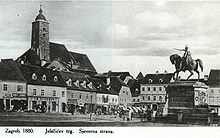Zagreb Cathedral
| Zagreb Cathedral | |
|---|---|
|
Native name Croatian: Zagrebačka katedrala | |
 Zagreb Cathedral | |
| Location | Zagreb, Croatia |
| Coordinates | 45°48′52″N 15°58′47″E / 45.81444°N 15.97972°ECoordinates: 45°48′52″N 15°58′47″E / 45.81444°N 15.97972°E |
| Built | 1880.–1906. |
| Architect | Hermann Bollé |
| Architectural style(s) | Neo-Gothic cathedral |
| Governing body | Zagrebačka katedrala |
| Official name: Zagrebačka katedrala | |
| Type | Cultural |
| Denomination | Roman Catholic |
| Bishop | Josip Bozanić |
 Location of Zagreb Cathedral in Croatia
| |
The Zagreb Cathedral on Kaptol is a Roman Catholic institution and the tallest building in Croatia.[1] It is dedicated to the Assumption of Mary and to kings Saint Stephen and Saint Ladislaus. The cathedral is typically Gothic, as is its sacristy, which is of great architectural value. Its spires can be seen from many locations in the city.
History
Construction on the cathedral started in 1093, but the building was destroyed by the Tatars in 1242. At the end of the 15th century, the Ottoman Empire invaded Bosnia and Croatia, triggering the construction of fortification walls around the cathedral, some of which are still intact. In the 17th century, a fortified renaissance watchtower was erected on the south side, and was used as a military observation point, because of the Ottoman threat.
The cathedral was severely damaged in the 1880 Zagreb earthquake. The main nave collapsed and the tower was damaged beyond repair. The restoration of the cathedral in the Neo-Gothic style was led by Hermann Bollé, bringing the cathedral to its present form. As part of that restoration, two spires 108 m (354 ft) high were raised on the western side, both of which are now in the process of being restored as part of an extensive general restoration of the cathedral.
The cathedral is depicted on the reverse of the Croatian 1000 kuna banknote issued in 1993.[2]
When facing the portal, the building is 46 meters wide and 108 meters high.[3] The cathedral contains a relief of Cardinal Aloysius Stepinac with Christ done by the Croatian sculptor Ivan Meštrović. The cathedral was visited by Pope Benedict XVI on 5 June 2011 where he celebrated Sunday Vespers and prayed before the tomb of Blessed Aloysius Stepinac.
Gallery
-

1880 pre-earthquake view from Jelačić Square with old square spire
-
.jpg)
19th Century view with fortifications intact
-

The front facade
-

Eastern view
-
.jpg)
Aerial view
-
Nave of building
-

Sarcophagus of blessed Alojzije Stepinac.
-

Ornate main entry
-

Nave, altar and pulpit
-

Gargoyle on a Zagreb Cathedral
-

Zagreb skyline with cathedral in the background
-

Neo-Gothic tower on a Zagreb Cathedral
-

Zagreb Cathedral Gargoyle
-

Zagreb rooftops
See also
References
- ↑ Feđa Gavrilović (12 January 2012). "Razbijene zastarjele predrasude" [Obsolete prejudices shattered. Vijenac (in Croatian) (Matica hrvatska) (466). ISSN 1330-2787. Retrieved 29 June 2012.
- ↑ Croatian National Bank. Features of Kuna Banknotes: 1000 kuna. – Retrieved on 30 March 2009.
- ↑ MAKOV TEKST O ZAGREBAČKOJ KATEDRALI - glas-koncila.hr
External links
| Wikimedia Commons has media related to Zagreb Cathedral. |
- Zagrebačka katedrala (Croatian)
- "Đavlova glava u zagrebačkoj katedrali" (Croatian)
- Zagreb cathedral in the 1880 earthquake and its present day renovation (Croatian)
| ||||||||||||||||||||||||||||||||||
| |||||||||||||||||

